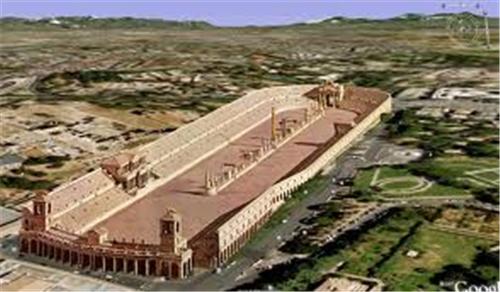From the vantage point of a hill, one could see over the ramparts in the distance, the seven hills, the imperial mound with its white palace, and the cupolas of the Hagia Sophia basilica. Constantinople, the jewel of the orient, shone like ivory and gold in its protective stone case. Red and yellow pennants, boasting the two-headed eagle of Byzantium, floated atop the massive, square watchtowers. The salty sea breeze carried the faint scent of spice and roasting lamb.
The front rampart walled the entire width of the peninsula, defending the city from an attack by land. The fortifications, almost as thick as they were tall, gleamed white in the bright sun. Elegant horizontal stripes of red and ochre bricks decorated the length and the edges. Square merlons crenellated the top, revealing the wide path atop the wall, where archers and soldiers in pointy helmets and short armor gathered, like an army of yellow and red ants, watching the legion from a distance.
The city gate, ensconced into the thick rampart, and protected on both sides by protruding walls, seemed impenetrable. The fortifications also surrounded the ancient metropolis on all sides, jutting out from the sea along the entire coast, forbidding invasion by an enemy fleet. Emperor Constantine the Great, seven centuries ago, had designed his fortress to be impregnable.
A wide open space fronted the fortifications. No doubt, past emperors had stripped bared this strategic area to gather and move their armies at will, and control the road in times of unrest. In case of enemy attack, it also provided an open battlefield, and a perfect killing ground, exposing the attackers.
Other, well traveled paths converged toward the city gate. A long line of carts and loaded camels, donkeys and bleating goats waited to be granted entry, alongside Bedouins in strange desert attire, with swaths of cloth covering their heads and most of their faces.
Above the gate, hung a monumental golden effigy of the two-headed eagle. The paved streets inside the city teemed with the traffic of merchants, horse carts and camels. Display tables, like an open market, overflowed with silks and spices from the orient, amphorae of wine or oil, and olives. Chattering monkeys stole fruit from the displays. The aroma of incense and perfume wafted in the air, along with so many enticing scents.
An enormous creature walked by, led by a turbaned man. An elephant. The beast trumpeted, causing the merchants to hold on to their wares, least they might fly away. A little farther, in a large bamboo cage, a big feline paced, tail twitching. A yellow-eyed tiger with black stripes. Close by, several alley cats feasted on the remains of the tiger's meal, a bloody pile of steaming entrails.
The calls of merchants in many languages mixed with animal sounds and smells, and the faraway toll of a church bell added to the strange music. The architecture of the city evoked the streets of ancient Rome, with colonnades, and balconies on the flat roofs of the two-story villas, so close together, they almost touched.
Varied people in colorful garb attested to the presence of many tribes from the confines of the known world. Some had flat, golden faces. Tribal women with shiny dark skin, wore scant clothing and many multicolored necklaces and bracelets... along with amulets and Shamanic symbols. Some had intricate markings on their hands and faces. Others hid their hair and body under long, silky veils, and black lines emphasized the contour of their eyes. Others yet wore anklets with tiny bells that jingled with each step like the tinkling chimes of a tambourine.
Further along, on a square, a large group of richly attired men surrounded a platform, where a few pale-skinned women stood, cowering as they attempted to hide their nudity. The sturdy blond man with a fur hat, who harangued his customers to examine them closely, looked like a Viking.
"Interested in some quality slaves from the land of the Russ?" The Viking trader winked at his customers from the height of the platform. "These beautiful Slavic girls and women, are all fertile and ready for hard work or pleasure."
 |
| The Egyptian obelisk still stands |
And crowning the hill, the white marble palace and the domes of the basilica, on a backdrop of deep blue sea.
Vijaya Schartz, fiction author
Blasters, Swords, Romance with a Kick
http://www.vijayaschartz.com
http://bookswelove.net/authors/vijaya-schartz/




No comments:
Post a Comment